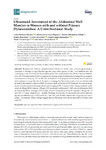Mostrar o rexistro simple do ítem
Ultrasound Assessment of the Abdominal Wall Muscles in Women with and without Primary Dysmenorrhea: A Cross-Sectional Study
| dc.contributor.author | Romero Morales, Carlos | |
| dc.contributor.author | Cueva Reguera, Mónica de la | |
| dc.contributor.author | Miñambres-Vallejo, Beatriz | |
| dc.contributor.author | Ruiz Ruiz, Beatriz | |
| dc.contributor.author | Calvo-Lobo, César | |
| dc.contributor.author | Casado-Hernández, Israel | |
| dc.contributor.author | López-López, Daniel | |
| dc.contributor.author | Abuín-Porras, Vanesa | |
| dc.date.accessioned | 2020-04-15T14:07:30Z | |
| dc.date.available | 2020-04-15T14:07:30Z | |
| dc.date.issued | 2020-03 | |
| dc.identifier.citation | Romero-Morales, C.; de la Cueva-Reguera, M.; Miñambres-Vallejo, B.; Ruiz-Ruiz, B.; Calvo-Lobo, C.; Casado-Hernández, I.; López-López, D.; Abuín-Porras, V. Ultrasound Assessment of the Abdominal Wall Muscles in Women with and without Primary Dysmenorrhea: A Cross-Sectional Study. Diagnostics 2020, 10, 166. | es_ES |
| dc.identifier.issn | 2075-4418 | |
| dc.identifier.uri | http://hdl.handle.net/2183/25333 | |
| dc.description.abstract | [Abstract] Background: Primary dysmenorrhea (PD) is one of the most common gynecological disorders in women of reproductive age that may affect quality of life. It is believed that the underlying cause of PD may be the excessive production of prostaglandins (PGs), however, between 20%–25% of women with PD did not respond to pharmacological treatments, showing that nociceptive mechanisms underlying PD are still not understood. The purpose of this study was to measure and compare, through the use of ultrasound imaging, the thickness at rest of the abdominal wall, as well as the interrecti distance (IRD), in women with and without PD. Methods: A cross-sectional study has been performed using ultrasound imaging (USI) to measure the resting thickness of the external oblique (EO), internal oblique (IO), transversus abdominis (TrAb), rectus abdominis (RA), as well as the IRD in a sample of 39 women, 19 with PD and 20 without PD (median ± IR age: 20 ± 4 and 22.5 ± 7 years, respectively). Results: Findings of muscular thickness did not reveal statically significant differences (p < 0.05) in EO, IO, TrAb, RA, and the IRD between the PD group and control group. Conclusions: These findings suggest that the thickness of the abdominal wall is not associated with PD. | es_ES |
| dc.language.iso | eng | es_ES |
| dc.publisher | MDPI AG | es_ES |
| dc.relation.uri | https://doi.org/10.3390/diagnostics10030166 | es_ES |
| dc.rights | Atribución 4.0 España | es_ES |
| dc.rights.uri | http://creativecommons.org/licenses/by/4.0/es/ | * |
| dc.subject | Primary dysmenorrhea | es_ES |
| dc.subject | Ultrasound imaging | es_ES |
| dc.subject | Abdominal wall | es_ES |
| dc.title | Ultrasound Assessment of the Abdominal Wall Muscles in Women with and without Primary Dysmenorrhea: A Cross-Sectional Study | es_ES |
| dc.type | info:eu-repo/semantics/article | es_ES |
| dc.rights.access | info:eu-repo/semantics/openAccess | es_ES |
| UDC.journalTitle | Diagnostics | es_ES |
| UDC.volume | 10 | es_ES |
| UDC.issue | 3 | es_ES |
Ficheiros no ítem
Este ítem aparece na(s) seguinte(s) colección(s)
-
GI-UDISAP - Artigos [196]






